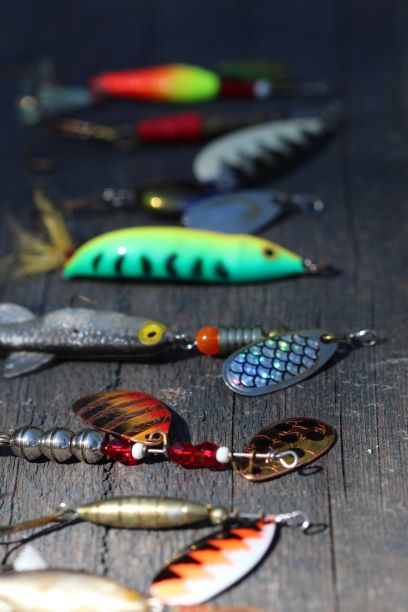Thinking of traveling to New Zealand and hoping to do some trout fishing. In this article we discuss the key differences in the commonly used spinning lures available in both countries.
I feel it is also important to note that trout are trout and despite living an ocean apart, they share very similar feeding habits. Equipment which works well in one country, likely also works well in another.
If there was one key difference, New Zealand’s trouts are predominately wild fish. While many of the fisheries in America see regular stockings. The feeding habits of wild and stock trout do differ.
Abu Garcia Toby
The most iconic trout spinner in New Zealand has to be the black and gold toby. A type of casting spoon. The creation of the Toby dates back to 1956, Denmark where it was created to replicate a toby fish. It quickly become apparent that the Toby was an excellent trout lure and with the power of the Abu Garcia brand behind it the Toby quickly become one of the best selling lures in history.
Meanwhile, a local manufacturer, Kilwell picked up the rights for the Toby in NZ, and they license their own version, calling it the Kilwell Turbo. Exact sale figures are impossible to know, but even today the Kilwell Turbo is a very popular and widely recommended trout lure.
While an international sensation, the Toby never really got established in North America and today they are a very rare sight indeed. Out of all lures, and designs. I feel the presence of the Toby casting spoon is the biggest difference between lure boxes of the two countries.
In-Line Spinners
In-line spinners, are very popular lures in both countries. But even more so in the united states. I doubt anyone will disagree that in-line spinners are the best selling trout lure in America. They are just so effective for river and stream trout.
In New Zealand, two brands dominate the shelves of the tackle stores. These are Mepps and Blue Fox Vibrax. Vibrax are such a popular choice that some anglers even refer to all ‘spinning blade’ lures as Vibraxes. Yes, the name has become a noun.
Things are not that difference in America, but depending on region, I feel Blue Fox seats in a distant third. With most popular in-line spinners being Mepps and panther Martin. Not to mention the many other brands such as Rooster tail, Joe Flies and several others which have made a name for themselves. As a segment of the market, the inline spinner is certainly more dominate in North America.
Jerkbait
Opinions differ quite significantly towards jerkbaits. In America, it is a rare sight to see a trout fishermen using Rapalas, with most having none, or only one or two in their tackle boxes. Contrastly, they are very popular in New Zealand, I will hazard a guess that they might even be the most popular style of trout lures. But, the competition is fierce for first place. The high price certainly discourages many from fishing them.
One of the biggest differences is simply in the naming, New Zealand anglers never call them jerkbaits. They simply refer to them as Rapalas or minnows. The dominance of the Rapala brand is well entrenched. There are several other contenders such as the Australian based Halco and the Japeanse Yo-zuri lures often sharing shelf space. In recent years Salmo and jerkbaits from Shimano and even daiwa have started becoming more common, but they are typically in larger sizes and more directed at saltwater fishing.
In America, Jerkbaits are seen more as a bass lure, but there is a growing number of trout fishermen who recognize just how effective they have become. Rapala, alongside Yo-zuri are certainly popular options. Alongside them seat a multitude of brands targeting bass, many of them also make lures, especially in the smaller sizes which are effective trout lures. Two newer brands, which have started to make a name for themselves among trout anglers are HD lures and Trout Magnets.
Acme Kastmaster
The Acme Kastmaster is a very popular lure for trout fishing in North America. The lure is an efficient caster and trolls well. What if I were to mention that I have never seen a Acme Kastmaster in New Zealand. That brand simply does not exist.
New Zealand trout fishermen simply prefer locally produced variations such as the Kilwell Hexagon wobbler. As a distant casting lure, they also compete against the iconic toby. While they remain a popular lure for casting at rivermouths, esepically targeting migrating salmon. They have become a rarer sight on trout rivers.
I do not doubt, some still fish them, and even rate them highly but this lure design has certainly fallen out of popularity in New Zealand.
Spoons
Some people consider Toby’s and Kastmasters are spoons. I do not disagree, but in this section I am referring to the more traditional style of trout fishing spoons. In New Zealand, they are a popular option among Salmon anglers, especially the dense and quick sinking Zeddies but I honestly never seen anyone directly targeting trout with them.
In the US, spoons still have quite the following among trout fishermen. The lighter ones are good for fluttering across streams, and the heavier ones are very popular trout trolling lures. If I were to think of trout spoons in America, I immediately think of the Thomas Bouyant, Eppinger Daredevle and the ACME little cleo.
Tasmanaina Devil
These winged lures were an Australian invention, and they eventually made their way over to New Zealand. When I first started trout angling, I remember the large displays of various Devils and Kobras available for sale.
Tasmania devils are a popular casting and trolling lures and certainly have a widespread following.
Contrasty, they barely exist in America. Although with the help of the internet they are usually available from Ebay or Amazon.

